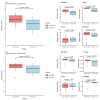Characterization of Gut Microbiota in Patients with Active Spreading Vitiligo Based on Whole-Genome Shotgun Sequencing
- PMID: 40243573
- PMCID: PMC11988336
- DOI: 10.3390/ijms26072939
Characterization of Gut Microbiota in Patients with Active Spreading Vitiligo Based on Whole-Genome Shotgun Sequencing
Abstract
Vitiligo is an autoimmune skin disease with a significant psychological burden and complex pathogenesis. While genetic factors contribute approximately 30% to its development, recent evidence suggests a crucial role of the gut microbiome in autoimmune diseases. This study investigated differences in gut microbiome composition and metabolic pathways between active spreading vitiligo patients and healthy controls using shotgun whole-genome sequencing in a Korean cohort. Taxonomic profiling reveals distinct characteristics in microbial community structure, with vitiligo patients showing an imbalanced proportion dominated by Actinomycetota and Bacteroidota. The vitiligo group exhibited significantly reduced abundance of specific species including Faecalibacterium prausnitzii, Faecalibacteriumduncaniae, and Meamonas funiformis, and increased Bifidobacterium bifidum compared to healthy controls. Metabolic pathway analysis identified significant enrichment in O-glycan biosynthesis pathways in vitiligo patients, while healthy controls showed enrichment in riboflavin metabolism and bacterial chemotaxis pathways. These findings provide new insights into the gut-skin axis in vitiligo pathogenesis and suggest potential therapeutic targets through microbiota modulation.
Keywords: autoimmune; dysbiosis; gut microbiome; metabolic pathways; shotgun sequencing; vitiligo.
Conflict of interest statement
The authors declare no conflicts of interest.
Figures









Similar articles
-
Insights into the gut microbiome of vitiligo patients from India.BMC Microbiol. 2024 Oct 28;24(1):440. doi: 10.1186/s12866-024-03529-5. BMC Microbiol. 2024. PMID: 39468434 Free PMC article.
-
A shotgun metagenomic study identified short-chain fatty acid-producing species and their functions in the gut microbiome of adults with depressive symptoms: Large-scale shotgun sequencing data of the gut microbiota using a cross-sectional design.J Affect Disord. 2025 May 1;376:26-35. doi: 10.1016/j.jad.2025.01.149. Epub 2025 Jan 31. J Affect Disord. 2025. PMID: 39894225
-
Analysis of Matched Skin and Gut Microbiome of Patients with Vitiligo Reveals Deep Skin Dysbiosis: Link with Mitochondrial and Immune Changes.J Invest Dermatol. 2021 Sep;141(9):2280-2290. doi: 10.1016/j.jid.2021.01.036. Epub 2021 Mar 24. J Invest Dermatol. 2021. PMID: 33771527
-
Understanding the Role of the Gut Microbiome and Microbial Metabolites in Non-Alcoholic Fatty Liver Disease: Current Evidence and Perspectives.Biomolecules. 2021 Dec 31;12(1):56. doi: 10.3390/biom12010056. Biomolecules. 2021. PMID: 35053205 Free PMC article. Review.
-
Beyond skin deep: exploring the complex molecular mechanisms and holistic management strategies of vitiligo.Arch Dermatol Res. 2025 Apr 8;317(1):685. doi: 10.1007/s00403-025-04162-6. Arch Dermatol Res. 2025. PMID: 40198440 Review.
Cited by
-
The Effect of Microbiome-Derived Metabolites in Inflammation-Related Cancer Prevention and Treatment.Biomolecules. 2025 May 8;15(5):688. doi: 10.3390/biom15050688. Biomolecules. 2025. PMID: 40427581 Free PMC article. Review.
References
MeSH terms
Grants and funding
LinkOut - more resources
Full Text Sources
Medical

